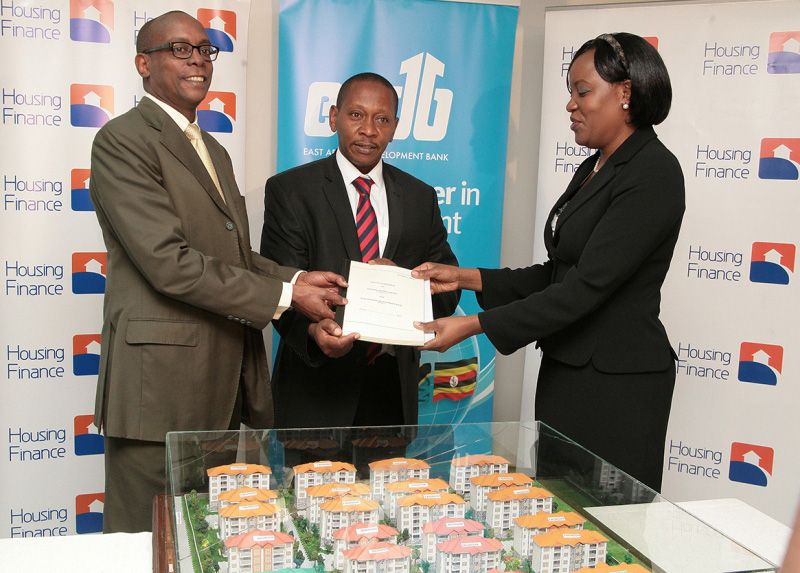SIGNING OF A FACILITY AGREEMENT FOR DEVELOPMENT OF RESIDENTIAL ESTATE
Nairobi, Kenya
February 20, 2014
Remarks by the EADB Director General, Vivienne Yeda
Mr. Frank Ireri, the Managing Director of Housing Finance,
Officials of Kahawa Downs Ltd
Members of the press
Ladies and gentlemen
I am honoured to join you today at the signing of this facility agreement between EADB, Housing Finance and Kahawa Downs Ltd. I take this opportunity to express my appreciation to both Housing Finance and Kahawa Downs for coming up with this initiative, which we believe will have a significant impact on Kenya’s housing sector and the economy in general. EADB is pleased to be a part of this initiative
This KES620 million facility will go towards the development of a residential estate (Kahawa Gardens Apartments) through the construction of apartment units together with ancillary infrastructure and other improvements serving the estate. The housing units are earmarked for sale to the mid-market income segment of the economy.
EADB is no stranger to this sector having invested more than USD 90 million in the construction sector in the last few years underscoring our commitment to the development of adequate housing and shelter for the populations of our Member States.
Ladies and gentlemen, housing is recognized as an economic, social and cultural right under a number of international human rights instruments including the Universal Declaration of Human Rights. It is also a right recognized in the Kenyan Constitution. We all appreciate the special place of housing because it is not possible for anyone to enjoy a decent living standard without adequate housing and shelter.
Adequate and safe housing ranks at the top our life’s priorities. Unfortunately, many in our region cannot afford adequate housing and shelter due to high cost of finance, high cost of building materials and the general absence of affordable housing. It is also noted that the middle class in many of our urban centres typically reside in housing units that were developed for low income earners, thus pushing the latter to informal settlements where basic facilities such as sanitation, water, lighting, security arrangements and other basic amenities, are lacking. The supply of housing units is acute especially for the low-income earners where supply lags behind demand. The housing challenge facing the region, therefore, is to ensure sufficient housing supply for all segments of the population.
The Government of Kenya targets to develop 200,000 units annually against the projected annual demand of 206,000 units of which 82,000 are in urban areas. This target translates to about 1 million units in 5 years through Public Private Partnership arrangements. This is a very ambitious target which calls for innovative delivery models to accomplish. Scarcity of finance and land make PPPs very ideal in achieving this target.
Figures from the 2009 population census indicated that over 30% of the Country’s population live in slums. In Nairobi alone, over 1 million residents out of a population of 3.2 million live in slums, with only 3% living in a house with permanent walls, water and electricity.
As Kenya works towards the realization of Vision 2030, EADB believes that the building and construction sector represents an important area for economic growth. Investing in this sector can create jobs and can be the solution to the mushrooming of unplanned and informal settlements in and around urban areas.
The growth of the middle class, which currently is estimated at 45% of the population (according to a study by AfDB), rapid urbanization and the emergence of growth centres around County Governments, presents a real business opportunity for both the private and public sectors in provision of housing to meet the growing demand. Urban population increased from 5.4 million in 1999 to an estimated 14.24 million in 2012 and is projected to increase to 17.64 million in 2017.
I commend Housing Finance and Kahawa Downs Ltd for picking the cue and coming up with this initiative, which will enable 220 middle class families (approximately 800 people) to own their own homes mainly with financing from Housing Finance. This will help bridge the deficit in provision of housing to the mid-market income segment and contribute to the achievement of Vision 2030.
I look forward to the completion of this project and to the handing over of keys to families. It is one of those projects which touch my heart because it contributes in more ways than one to the realization of our mandate: sustainable development of our region.
Thank you very much
Ends/Thursday February 20, 2014
